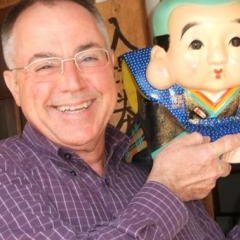Mr. Doi is a licensed tour guide with excellent knowledge of the sights to see in Kyoto. He speaks excellent English and will take his customers to locations of their choosing or he will recommend the places to see. He has the honor of having been President Clinton's tour guide when he visited Kyoto.
We started with a drive through the Gion District and a stop for some scenic photos by the small Yasaka Shrine and the small river that runs through the area. Gion is best known as the Geisha district in Kyoto. Doi-san pointed out the house where Mineko Iwasaki lived. She was the geisha whose partial story was used in the movie "Memoirs Of A Geisha."
Next we headed for Nijo Castle. We spent over 90 minutes walking through the castle and listening to Mr. Doi's good explanations of what the rooms were used for, some of the history of the Tokugawa family, and other interesting facts about the castle and the daimyo of long ago. The castle was completed in 1626 as the residence of the Tokugawa shoguns. Various buildings in the castle have been destroyed by fires over the years, but many have been rebuilt and the garden is also very nice to walk through. There is a magnificent kuromatsu (black pine) tree that started life as a bonsai tree over 400 years ago. When the last shogun left the castle the tree was taken out of its bonsai pot, replanted, and is now a large and interestingly shaped full size tree. Doi-san even explained the difference between the akamatsu (red pines) and kuromatsu. One has soft needles, the other has hard and sharp needles, and of course the color of the bark is different (hence the names).
Our next stop was Kitano Tenmangu Shrine. This shrine is best known for the thousands of students (and/or their parents) who visit every year to pray for success in their studies and entrance exams for university or the high school of their choice.
After the brief stop at Kitano Tenmangu we headed for what may well be Kyoto's most famous temple, Kinkaku-ji (the Golden Pavilion). The official name of this temple is Rokuon-ji (Deer Garden Temple), but is more often called Kinkaku-ji due to the gold leaf covered pavilion. Be sure to check out the Phoenix on the roof. It's a good symbol, as Doi-san said, of the building rising from the ashes. The pavilion was burned down by a novice monk in 1950 who suffered from mental illness. The present building was finished in 1955. Check the photo on the wall of what looks to be an indoor swimming pool on the top floor. It's not, of course. It's the superb lacquer used to coat the floor and the reflection of the gold leaf ceiling inside the building.
After a stroll through the garden on the way back to the parking lot we stopped for some of the packaged snacks sold at the entrance.
Our four hours were nearly up by this time so we piled into Doi-san's van for the ride to our ryokan where Mr. Doi dropped us off and bid us farewell. It was great value at 5,400 yen per hour.
Read Day 3 to learn more about our ryokan and final day in Kyoto.
































